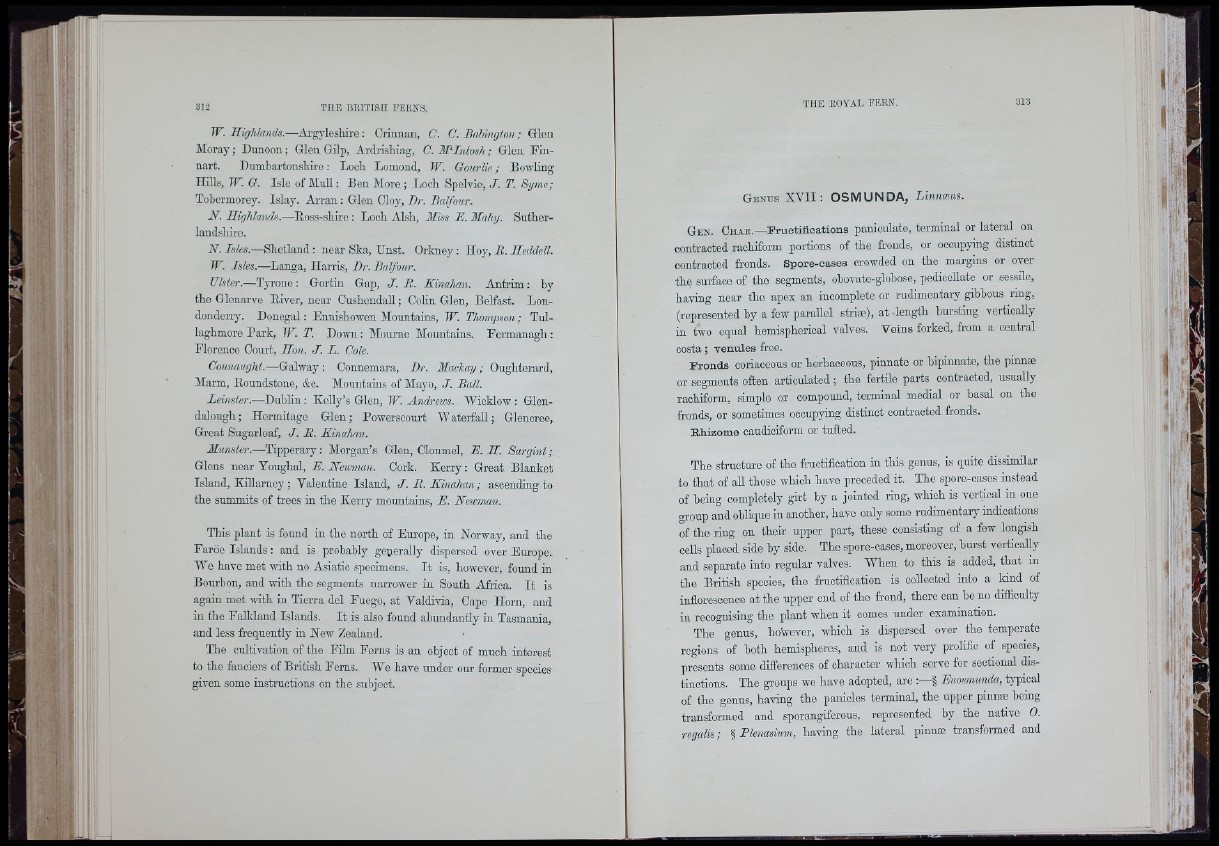
\k i
pir-'!
li, '
Si
■ f f
IÎ
312 THE BRITISH FERNS.
TF. Highlands.—ili-gyleshire: Crinnan, C. C. BaUngton; Glen
Moray; Dunoon; Glen Gilp, Ardrishiag, C. M'Intosh; Glen Fin-
nart. Dumbartonshire: Loch Lomond, TF. Oourlie; Bowling
Hills, TV. G. Isle of MuU : Ben More ; Loch Spelvio, J. T. Syme;
Tohcrmorey. Islay. Arran: Gleu Cloy, Br. Balfour.
N. Highlands.—^Ross-shire : Loch Alsh, Miss E. Mahy. Suther-
landshiro.
N. Isles.—Shetland: near Ska, TJnst. Orkney: Hoy, P . Heddell.
TTk Isles.—^Langa, Harris, Br. Balfour.
Ulster.—T}Tone: Gortin Gap, J. P . Kinahan. Antrim: by
the Glenarve River, near CushendaU; Colin Glen, Belfast. Londonderry.
Donegal: Ennishowen Mountains, TV. Ihompson; Tul-
laghmore Park, TV. I . Down: Mourne Mountains. Fermanagh:
Florence Court, Hon. J. L. Cole.
Connaught.—Galway ; Connemara, Br. Machay; Oughterard,
Marm, Roundstone, &o. Mountains of Mayo, J. Ball.
Leinster.—Dublin; Kelly’s Glen, TV. Andrea's. Wicklow : Glendalough;
Hermitage Glen; Powersoourt WaterfaU; Glencree,
Great Sugarloaf, J. P. Kinahan.
Munster.—Tipperary: Morgan’s Glen, Clonmel, E. H. Sargint;
Glens near Youghal, E. Newman. Cork. Kerry: Great Blanket
Island, KiUarney; Valentine Island, J. P . Kinahan; ascending to
the summits of trees in the Kerry mountains, E. Newman.
This plant is found in the north of Europe, in Norway, and the
Faroe Islands : and is probably goperally dispersed over Europe.
We have met with no Asiatic specimens. It is, however, found in
Bourbon, aud with the segments narrower in South Africa. It is
again met with in Tierra del Euego, at Valdivia, Cape Horn, and
in the Falkland Islands. It is also found abundantly in Tasmania,
and less frequently in New Zealand.
The cultivation of the Film Ferns is an object of much interest
to the fanciers of British Ferns. We have under our former species
given some instructions on the subject.
ft iI ' l-I
THE ROYAL FERN. 313
m
If rii
Genus X V I I : O S M U N D A , Linnoeus.
G e n . C h a k .— Fructifloations paniculate, terminal or lateral ou
contracted rachiform portions of the fronds, or occupying distinot
contracted fronds. Spore-cases crowded on the margins or over
the surface of the segments, obovate-globose, pedicellate or sessile,
having near the apex an incomplete or rudimentary gibbons ring,
(represented hy a few paraUel striæ), at length bursting vertically
in two equal hemispherical valves. Veins forked, from a central
oosta ; venules free.
Fronds coriaceous or herbaceous, pinnate or bipinnate, the pinnæ
or segments often articulated ; the fertile parts contracted, usuaUy
raohiform, simple or compound, terminal medial or basal on the
fronds, or sometimes occupying distinot contracted fronds.
BMzome oaudiciform or tuftod.
The structure of tho fruotifioation in this genus, is quite dissimUar
to that of aU those which have preceded it. The spore-oases instead
of being completely girt by a jointed ring, which is vertical in one
group and oblique in another, have only some rudimentary indications
of the ring on their upper part, these consisting of a few longish
cells placed side by side. The spore-cases, moreover, burst verticaUy
and separate into regular valves. When to this is added, that m
the British species, the fructifleation is collected into a kind of
inflorescence at the upper end of the frond, there can be no difficulty
in recognising the plant when it comes under examination.
The genus, however, which is dispersed over the temperate
regions of both hemispheres, and is not very prolific of species,
presents some differences of character which serve for sectional distinctions.
The groups we have adopted, are :—§ Euosmunda, typical
of the genus, having the panicles terminal, the upper pinnæ heing
transformed and sporangiferous, represented hy the native 0.
regalis ; § Plenasium, having the lateral pinnæ transformed and
:ll
rifl
.ri
i l ti
ff - t il
I*-!
iii!
4
if
1Ÿ